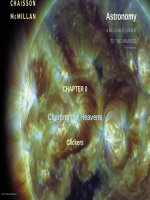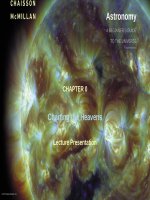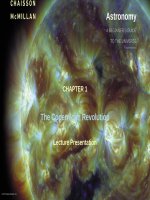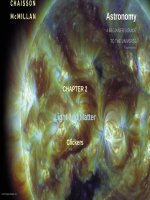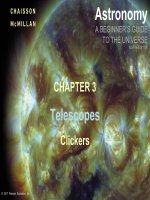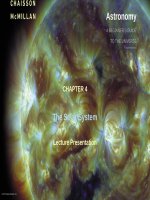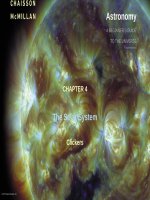Astronomy a beginners guide to the universe 8th CHaisson mcmillan chapter 04
Bạn đang xem bản rút gọn của tài liệu. Xem và tải ngay bản đầy đủ của tài liệu tại đây (3.95 MB, 38 trang )
Astronomy
A BEGINNER’S GUIDE
TO THE UNIVERSE
EIGHTH EDITION
CHAPTER 4
The Solar System
Lecture Presentation
© 2017 Pearson Education, Inc.
Chapter 4 The Solar System
© 2017 Pearson Education, Inc.
Units of Chapter 4
•
•
•
•
•
An Inventory of the Solar System
Interplanetary Matter
Formation of the Solar System
Planets Beyond the Solar System
Summary of Chapter 4
© 2017 Pearson Education, Inc.
4.1 An Inventory of the Solar System
•
Early astronomers knew about the Moon, stars, Mercury, Venus, Mars, Jupiter, Saturn,
comets, and meteors.
•
Now known: Solar system
has 1 star, 169 moons
orbiting 8 planets (added
Uranus and Neptune),
asteroids, comets,
meteoroids, dwarf planets,
and Kuiper belt objects.
© 2017 Pearson Education, Inc.
4.1 An Inventory of the Solar System
© 2017 Pearson Education, Inc.
4.1 An Inventory of the Solar System
•
•
•
•
•
•
Distance from Sun known by Kepler’s laws.
Orbital period can be observed.
Radius known from angular size.
Masses known from Newton’s laws.
Rotation period known from observations.
Density can be calculated knowing radius and mass.
© 2017 Pearson Education, Inc.
4.1 An Inventory of the Solar System
•
All orbits but Mercury’s are close to the same plane.
© 2017 Pearson Education, Inc.
4.1 An Inventory of the Solar System
© 2017 Pearson Education, Inc.
4.1 An Inventory of the Solar System
•
Terrestrial planets:
–
•
Mercury, Venus, Earth, Mars
Jovian planets:
–
Jupiter, Saturn, Uranus, Neptune
© 2017 Pearson Education, Inc.
4.1 An Inventory of the Solar System
•
Differences between the terrestrial planets:
–
–
–
Atmospheres and surface conditions are very dissimilar.
Only Earth has oxygen in atmosphere and liquid water on surface.
Earth and Mars rotate at about the same rate; Venus and Mercury are much slower, and
Venus rotates in the opposite direction.
–
–
Earth and Mars have moons; Mercury and Venus don’t.
Earth and Mercury have magnetic fields; Venus and Mars don’t.
© 2017 Pearson Education, Inc.
4.2 Interplanetary Matter
•
The inner solar system, showing the asteroid belt, Earth-crossing asteroids, and Trojan
asteroids
© 2017 Pearson Education, Inc.
4.2 Interplanetary Matter
•
The path of Icarus, an Earth-crossing asteroid
© 2017 Pearson Education, Inc.
4.2 Interplanetary Matter
•
Asteroids and meteoroids have rocky composition; asteroids are bigger.
(below) Asteroid
Mathilde
(above) Asteroid Ida with its
moon, Dactyl
© 2017 Pearson Education, Inc.
(above) Asteroid
Itokawa
Discovery 4.1: What Killed the Dinosaurs?
•
•
The dinosaurs may have been killed by the impact of a large meteor or small asteroid.
The larger an impact is, the less often we expect it to occur.
© 2017 Pearson Education, Inc.
4.2 Interplanetary Matter
•
Asteroid Eros
© 2017 Pearson Education, Inc.
4.2 Interplanetary Matter
•
•
Comets are icy, with some rocky parts.
The basic components of a comet
© 2017 Pearson Education, Inc.
4.2 Interplanetary Matter
•
The solar wind means the ion tail always
points
away from the Sun.
•
The dust tail also tends to point away from
the
Sun, but the dust particles are more
massive and lag somewhat, forming a
curved tail.
© 2017 Pearson Education, Inc.
4.2 Interplanetary Matter
•
Jets carry gas and dust away from the comet’s nucleus as it is warmed by the Sun.
© 2017 Pearson Education, Inc.
4.2 Interplanetary Matter
•
The size, shape, and orientation of
cometary
orbits depend on their location. Oort cloud
comets rarely enter the inner solar system.
© 2017 Pearson Education, Inc.
4.2 Interplanetary Matter
•
Meteor showers are associated with comets—they are the debris left over when a comet
breaks up.
© 2017 Pearson Education, Inc.
4.2 Interplanetary Matter
© 2017 Pearson Education, Inc.
4.2 Interplanetary Matter
•
•
The impact of a large meteor can create a significant crater.
The Barringer meteor crater in Arizona
© 2017 Pearson Education, Inc.
4.2 Interplanetary Matter
•
The Manicouagan reservoir in Quebec
© 2017 Pearson Education, Inc.
4.3 The Formation of the Solar System
•
Nebular contraction: Cloud of gas and dust
contracts due to gravity; conservation of
angular momentum means it spins faster
and faster as it contracts.
© 2017 Pearson Education, Inc.
4.3 Formation of the Solar System
•
Condensation theory:
–
Condensation occurs when gas cools
and changes its
state to become tiny solid particles.
–
Interstellar dust grains act as
condensation nuclei.
© 2017 Pearson Education, Inc.
